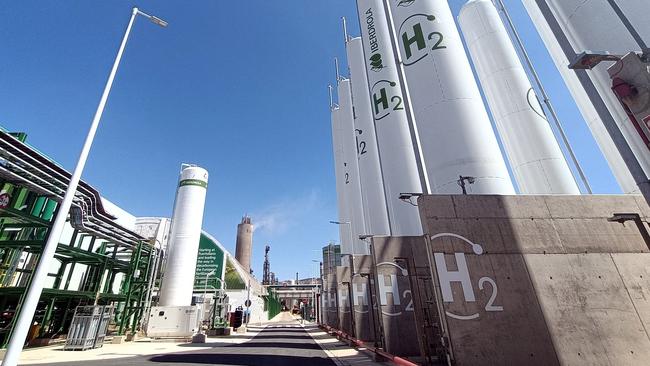SA hydrogen power plant may use River Murray water, CEO reveals in parliament
SA’s hydrogen plant may use River Murray water, it’s been revealed by the project’s CEO, who has also confirmed energy storage plans have changed.
SA News
Don't miss out on the headlines from SA News. Followed categories will be added to My News.
South Australia’s hyped green hydrogen future has been questioned with revelations the $593 million plant will suck water out of the River Murray.
The plant would use water to split oxygen and hydrogen atoms to form flammable hydrogen gas.
The state government is also considering a business case for the 5.3 gigalitre Northern Water desalination project, which it said “would provide a secure and scalable source of quality water to support the hydrogen jobs plan”.
Under intense questioning in parliament the Office of Hydrogen Power CEO Sam Crafter revealed the hydrogen plant was set to tap SA’s water supply.
“That (water supply) will involve solutions from existing SA Water infrastructure, and some of that comes from the Murray, so we will potentially need to access that,’’ he said.
“We haven’t finalised that work yet, and we are going through a process to be able to work that out and what that means for the Upper Spencer Gulf and water supply to the region more broadly as well.”

Hydrogen plants are large users of water, needing 20 tonnes of water to make just one tonne of hydrogen.
Opposition energy spokesman Stephen Patterson seized on the admission the Whyalla plant may not be as green as claimed.
“We are the driest state in the driest continent in the world, and Peter Malinauskas doesn’t
know where he is sourcing the huge amounts of water needed to run this experimental
hydrogen plant that does nothing to reduce the cost of SA electricity bills,” he said.
Infrastructure Minister Tom Koutsantonis said the hydrogen power plant would enable lower power prices for industry, which should in turn help bring down cost-of living pressures.
“This critique looks like a desperate attempt by the coal-addicted Liberal Party, which failed to see a single new wind farm progress during its brief era of error, to further undermine South Australia’s green energy future,” Mr Koutsantonis said.
“To do so under the guise of environmentalism is particularly galling, from a party whose leader was found by a Royal Commission to have capitulated to the eastern states on River Murray negotiations to a degree contrary to South Australia’s interests.”
The parliamentary evidence has also ended debate about plans for a plan to include 3600 tonnes of liquefied hydrogen storage.
The Liberal Party has always rejected the project’s cost of $593m because of the high cost of storage, but this was denied by the Labor Party during the state election.
As recently as last December the project was still to include up to 3600 tonnes of storage in the $593m price tag, but when asked on Monday, Mr Crafter said; “No, it will not”.
Mr Crafter also repeatedly avoided questioning on the state government claim the plant would cut bills for business, saying only, “the targeted objective of this power plant is to lower prices for industrial customers”.
Mr Patterson said the appearance before the Budget and Finance Committee on Monday was revealing.
“As it stands, Labor’s hydrogen power plant seems more a fantasy than a reality with Peter
Malinauskas’ hand-picked chief executive unable to answer basic questions about how it will
work and what benefit taxpayers will see,’’ he said.




